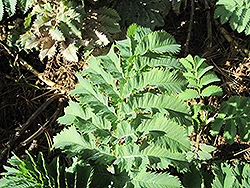Height: 8 feet
Spread: 10 feet
Sunlight:
![]()
![]()
Hardiness Zone: (annual)
Other Names: Honeybush, Peanut Butter Plant
Description:
A fabulous textured shrub with striking green and powdery blue foliage, arranged fern-like on arching stems; birds are attracted to the bold, nectar-rich red flowers in spring and summer; great for borders or containers
Ornamental Features
Honey Bush features showy clusters of fragrant dark red tubular flowers rising above the foliage from late spring to mid summer. Its attractive serrated narrow pinnately compound leaves remain grayish green in color with showy powder blue variegation throughout the year.
Landscape Attributes
Honey Bush is a multi-stemmed annual with an upright spreading habit of growth. Its relatively fine texture sets it apart from other garden plants with less refined foliage.
This is a relatively low maintenance plant, and should only be pruned after flowering to avoid removing any of the current season's flowers. It is a good choice for attracting birds to your yard. It has no significant negative characteristics.
Honey Bush is recommended for the following landscape applications;
- Accent
- Mass Planting
- Hedges/Screening
- General Garden Use
- Container Planting
Planting & Growing
Honey Bush will grow to be about 8 feet tall at maturity, with a spread of 10 feet. Its foliage tends to remain dense right to the ground, not requiring facer plants in front. Although it's not a true annual, this plant can be expected to behave as an annual in our climate if left outdoors over the winter, usually needing replacement the following year. As such, gardeners should take into consideration that it will perform differently than it would in its native habitat.
This plant does best in full sun to partial shade. It does best in average to evenly moist conditions, but will not tolerate standing water. It is not particular as to soil type or pH. It is somewhat tolerant of urban pollution. This species is not originally from North America.
Honey Bush is a fine choice for the garden, but it is also a good selection for planting in outdoor pots and containers. With its upright habit of growth, it is best suited for use as a 'thriller' in the 'spiller-thriller-filler' container combination; plant it near the center of the pot, surrounded by smaller plants and those that spill over the edges. It is even sizeable enough that it can be grown alone in a suitable container. Note that when growing plants in outdoor containers and baskets, they may require more frequent waterings than they would in the yard or garden.


